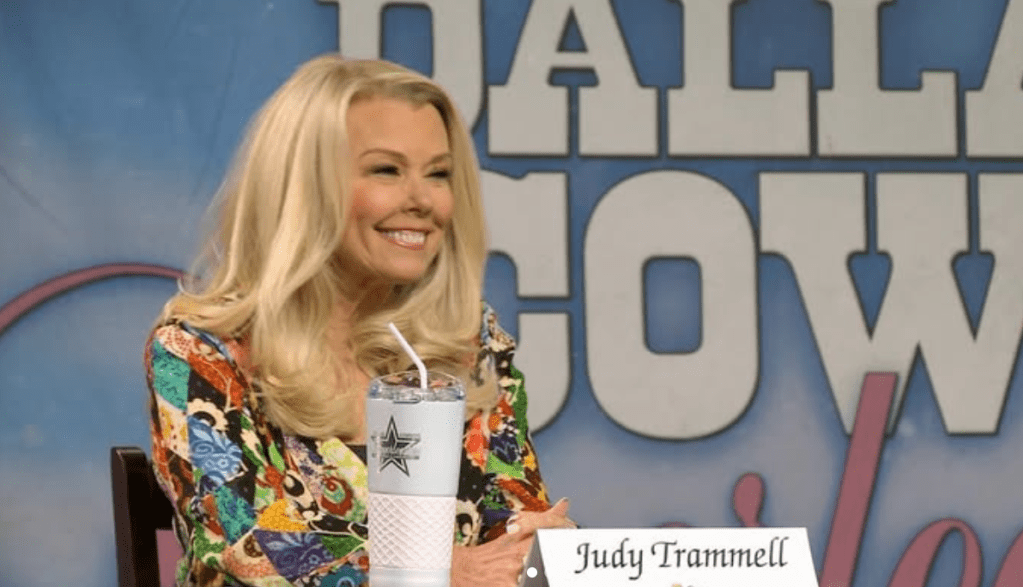Judy Trammell has choreographed the Dallas Cowboys Cheerleaders’ signature style, high kicks, and captivating twists with remarkable consistency over the past forty years. Her salary, which is estimated to be around $68,555 per year, is still the focus of growing interest and quiet curiosity despite decades of steadfast service. Her pay is remarkably comparable to mid-level creative positions in regional arts, rather than the elite sports stage she commands, for someone whose choreography appears on national broadcasts and halftime stages.
Her pay as of July 2025 is approximately $5,712 per month, or $1,318 per week, which equates to about $32.96 per hour. This figure seems surprisingly low when compared to NFL employees and creative professionals who oversee visual branding for sports teams. It is still far less than the six-figure contracts typical of other high-level NFL staffers, even though it is much higher than entry-level coaching salaries. However, it could be argued that Judy’s contribution has influenced the team’s visual identity more strongly than any advertising campaign or jersey redesign could.
Judy Trammell Biography Table
| Attribute | Details |
|---|---|
| Full Name | Judy Trammell |
| Date of Birth | April 29, 1958 |
| Age | 67 (as of 2025) |
| Spouse | Dick Trammell |
| Children | Taylor, Cassie, Blair |
| Notable Child | Cassie Trammell – former DCC and group leader |
| Dance Background | 16 years (jazz, tap, drill team) |
| DCC Cheerleader Tenure | 1980–1984 |
| Choreography Career Start | Assistant Choreographer (1984), Head Choreographer (1991–present) |
| Current Role | Head Choreographer, Dallas Cowboys Cheerleaders |
| Active Years with DCC | Over 40 years |
| Estimated Net Worth | $1.6 million |
| Average Estimated Salary | $68,555 annually |
| Reference |
Judy’s vision is largely realized in the DCC legacy, which is characterized by uniformity, performance precision, and glamour. After four seasons as a cheerleader, she began as an assistant choreographer in 1984 and has been choreographing the team since 1991. In addition to training generations of dancers, her inventiveness and talent for performing have helped establish the DCC as a brand. It is extremely uncommon and very admirable that she has continued to streamline performance routines and create legacy routines from scratch for such a long time.
Given that her daughter, Cassie Trammell, followed in her footsteps by dancing for the DCC from 2008 to 2013 and currently coaching the Junior DCC, her influence within the organization feels incredibly effective. Seeing this legacy develop over the years strengthens Judy’s reputation as a mentor influencing performance in addition to her role as a choreographer. By association, the Trammells have established themselves as a sort of dynasty within Texas football’s dance corridors.
Judy’s estimated net worth of $1.6 million is not the result of celebrity endorsement deals or commercial exploitation, but rather of meticulous career planning and enduring institutional loyalty. She has made a significant effort to remain quietly influential rather than dramatically monetize her reputation. Judy’s contributions have been firmly anchored in performance culture and precision coaching, whereas many contemporary influencers use posts and merchandise to convert visibility into quick cash.
Judy’s pay ranges widely across the country, depending on experience and skill level, from $55,500 to $78,500, with only top percentile professionals earning over $83,000, despite her pivotal role in a well-known franchise. This range seems especially limited when compared to creative directors of comparable caliber in commercial choreography, Broadway productions, or even music tours. Nevertheless, it says volumes about her that she still has a strong commitment to her dancers.
By drawing on her extensive background in dance and leadership, Judy has fostered culture in addition to choreography. Hours of body language training, synchronization coaching, and rehearsal management are all part of her behind-the-scenes job. While none of these responsibilities are glamorous, they all have a big impact on the team’s performance on international platforms. Although the results of that type of silent leadership are very evident, the compensation is frequently subtle.
The team has seen a rise in viewership and commercial engagement in recent days as reality shows and documentaries that revisit the DCC legacy have become popular on streaming platforms. If public interest keeps growing, these trends may eventually result in legacy figures like Judy earning more money. But for the time being, her pay is still based on service rather than show.
It’s not unusual for the athletes that creative leads frame to overshadow them in sports roles that have an entertainment component. Judy’s story resembles that of stylists behind red carpet stars or vocal coaches behind Grammy winners—important, but all too frequently paid just enough to maintain excellence without indulging in the extravagance they help market. This narrative keeps coming up and needs to be reconsidered.
It became more and more clear how important choreographed visuals and organized entertainment were during the pandemic, when sports teams were fighting to keep their performances intact without packed stadiums. Judy’s contribution during those times was not merely helpful; it was essential. However, despite the renewed focus on entertainment, her tier was not necessarily affected by salary inflation.
The Dallas Cowboys Cheerleaders have maintained their commercial viability and cultural resonance through strategic alliances and a steady on-field presence. Judy Trammell’s pay ought to be commensurate with her contributions over the years as well as her credibility. In addition to routine-building, it should assess brand continuity, talent development, and reputation-building.
Judy is a bright example that longevity is achievable, even in competitive entertainment settings, for dancers in their early careers who are considering leadership roles. Her story serves as a reminder and source of inspiration: not all forms of recognition are accompanied by commensurate financial compensation. Her work, however, has redefined what it means to lead from the back of the stage—calmly, creatively, and with unfathomable poise. It is especially inventive and incredibly durable.




